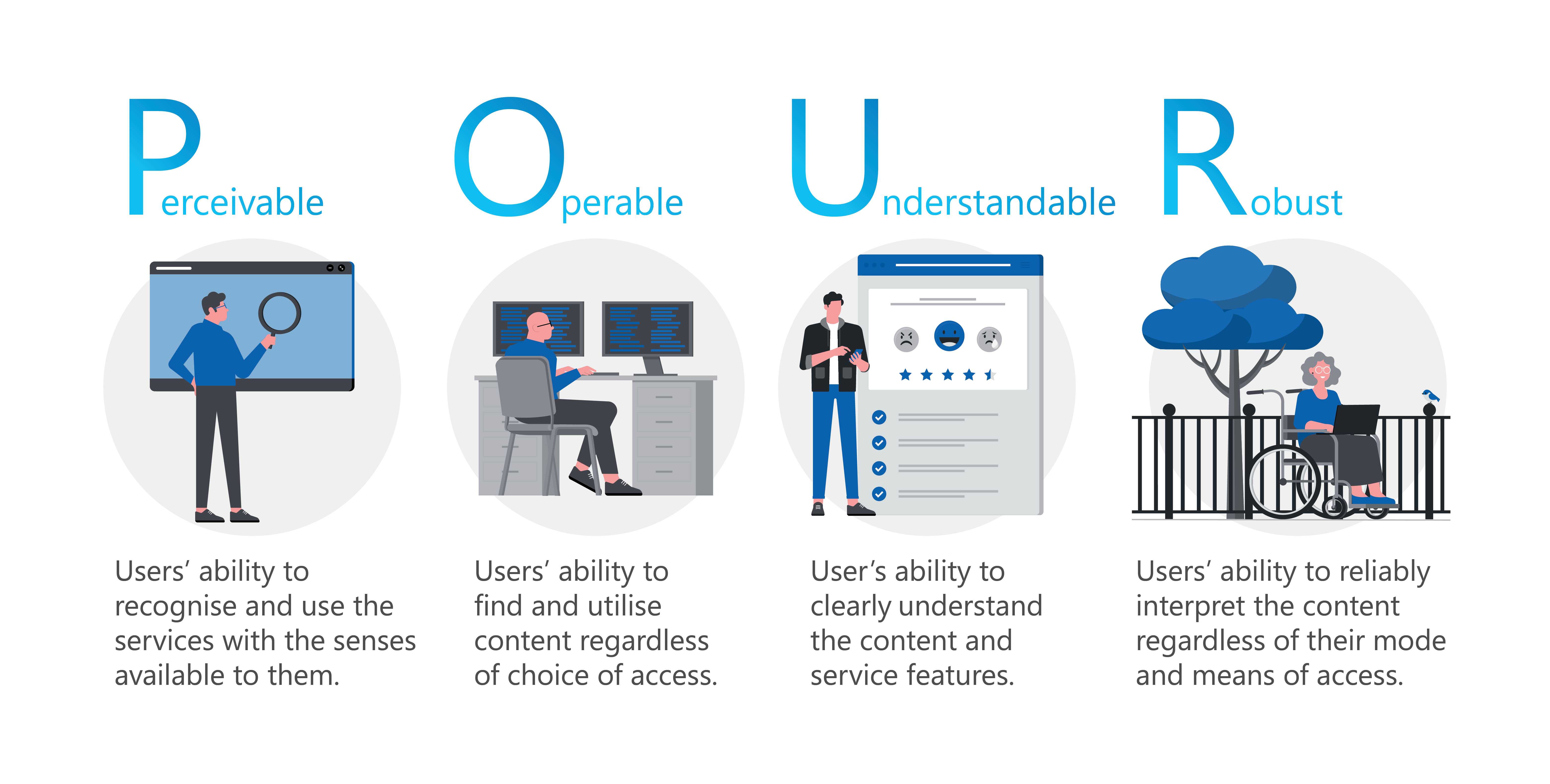Overview
More than one billion people or around 15% of the global population have a form of disability (World Bank, 2022). In Singapore, approximately 3% of residents experience varying difficulties performing at least one basic activity (Department of Statistics Singapore, 2020).
This has increased the importance of digital inclusion not just in the creation of assistive technologies but in ensuring that web content is accessible. The WCAG are a set of globally recognised guidelines for increasing the accessibility of web content for persons with disabilities, seniors who experience changing abilities due to ageing and everyday users who would also benefit from an improved user experience.
It was first published by the Web Accessibility Initiative (WAI) of the World Wide Web Consortium (W3C) on 9 Mar 1999, which is the main international organisation responsible for Internet standards. Version 2.1 is the latest rendition of the WCAG that covers new guidelines and success criteria such as mobile accessibility guidelines which were lacking in version 2.0. It was launched on 5 Jun 2018.
Objective
WCAG 2.1 aims to improve web accessibility for three major user groups:
- Persons with cognitive or learning disabilities
- Persons with low vision
- Persons who experience difficulties with mobile devices
Scope
WCAG 2.1 is applicable to all digital services, websites, applications, and platforms. It provides guidelines on areas such as:
- Presentation of content
- Multimedia
- Assistive technology
It is focused on design principles and not technology. This ensures that inclusion is not limited by technology and encourages organisations to improvise and be creative, which expands the possibilities for improving web accessibility.
Target Audience and Adoption Criteria
Although WCAG is not mandatory for countries to adopt, many countries such as Australia, the United Kingdom, European Union, and Canada have incorporated these guidelines into their laws and policies to ensure that digital content is accessible to everyone, including persons with disabilities. This is increasingly important given that more and more essential services are being digitalised.
In Singapore, although it is not incorporated into a law or policy for businesses and organisations to incorporate the WCAG, the Digital Service Standard (DSS) conforms to Level AA standards of the WCAG 2.1 and is mandatory for government agencies to incorporate into their digital services. The DSS comrpises a set of policies, standards and guidelines for achieving the Digital Government Blueprint (DGB)’s goal of delivering digital services that are easy to use, seamless and relevant to citizens and businesses.
More information on the DSS can be found in our DSS webpage.
Standards, Guidelines and Assessment Criteria

WCAG 2.1 is based on four design principles, otherwise known as POUR:
- Perceivable
Users must be able to recognise and use your services with the senses that are available to them. Examples of perceivable design are:
- Including text alternatives (‘alt text’) for non-text content
- Providing transcripts for audio and captions for videos
- Text colours can be viewed clearly against the background colour
- Operable
Users must be able to find and utilise your content regardless of how they choose to access it (e.g. via voice commands or search engines). Examples of operable content include:
- Ensuring that keyboard-only users are able to access and utilise your web features
- Adopting descriptive links which allow users to understand exactly where a link will take them and comprehend the type of hyperlinked content that will be downloaded
- Ensuring that keyboard users can clearly view the item their keyboard or assistive technology is currently focused on (active focus)
- Understandable
Users must be able to clearly understand your content and service features/functions. Examples of understandable content include:
- Ensuring that the language the content is written in, is clear and comprehendible. If any language changes occur, it is annotated clearly
- Ensuring that features are consistent and predictable/intuitive in their functionality
- Incorporating visible and meaningful labels for all form fields
- Robust
Users must be able to reliably interpret your web content regardless of their mode and means of access. This extends to outdated, current and anticipated browsers and assistive technologies. Examples of robust content include:
- Utilising HTML to allow user agents, including assistive technologies, to accurately interpret digital content
- Ensuring that your code is compatible and readable by assistive technologies
- Ensuring that important status messages or modal dialogues are marked up in a way that informs users of their presence and purpose and allows interactions with assistive technologies
Resources and Templates
What’s Next?
The next iteration of WCAG 2.1 is WCAG 2.2. This is targeted to be published in April 2023.
More information on WCAG 2.2 can be found in this W3C webpage.
Contact Information
Please fill up this form if you have further queries.
Last updated 18 April 2023
Thanks for letting us know that this page is useful for you!
If you've got a moment, please tell us what we did right so that we can do more of it.
Did this page help you? - No
Thanks for letting us know that this page still needs work to be done.
If you've got a moment, please tell us how we can make this page better.

